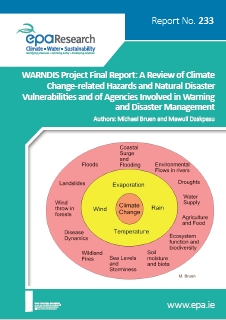Research 233: WARNDIS Project Final Report: A Review of Climate Change-related Hazards and Natural Disaster Vulnerabilities and of Agencies Involved in Warning
Authors: Michael Bruen and Mawuli Dzakpasu
Summary: The purpose of this study was to identify and review the main types of natural disasters that may be impacted by anticipated climate change; identify the key agencies involved; assess their roles and capabilities; and identify existing and new potential data streams to assist with warning and disaster management.

Identifying Pressures
Climate change brings new threats and uncertainties but also opportunities. It challenges us to both mitigate the threats and gain from the opportunities. This project looked specifically at the threats from natural hazards. A large number of these, such as floods, droughts, landslides and wildfires will be more intense and more frequent in many areas as will the threats from disease and ecosystems changes. Planning to mitigate their impacts requires a good understanding of the vulnerabilities and the public perception of the risks in order to develop effective strategies. Warning systems are key elements of such strategies. This desk study assesses the information available on climate induced change in all these areas. It also held a workshop to which were invited representatives of the agencies involved in hazard warning, disaster preparedness and relief. One of questions asked of the participants was to identify other areas of natural hazards so that as wide a range of such pressures as possible could be considered.
Informing Policy
The project reviewed the warning systems already in place at Global, European and National levels. It pointed to some International warning and information systems that can readily be used in Ireland and gave examples of their outputs. In addition, at the project workshop, the participants were asked to suggest new sources of information that could be useful in emergency response. The suggestions are listed in the report and are a useful checklist to inform future policy in enhancing the systems dealing with natural hazard impacts. The suggestions included making better use of existing information but also included suggestions for new or enhanced (e.g. resolution) data sources.
Developing Solutions
The project identified the main types of natural hazards and summarised the international literature on the possible impacts of each and the projections of how climate change may influence these impacts. The project brought together representatives of many of the agencies involved in warning and disaster management in Ireland. This in itself should help in making each aware of the capabilities, roles and responsibilities of the others, and especially the role played by local authorities. The project identified sources of tools and information from European and International agencies that can readily be used in Ireland and it identified ways of enhancing the quality and use of data and information collected within Ireland and useful new data sources.
https://www.epa.ie/media/epa-2020/publications/research/Research_233_thumbnail[1].jpg